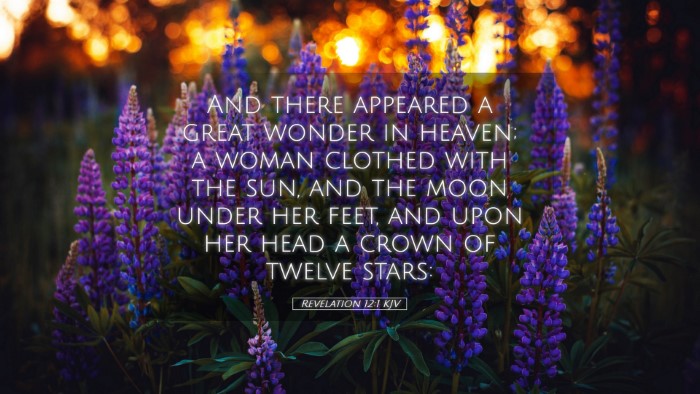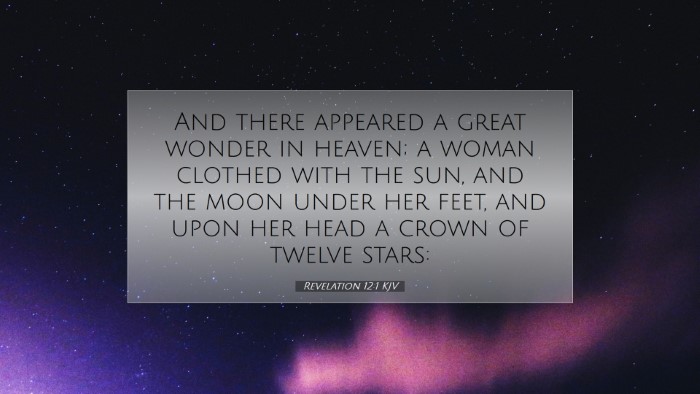Commentary on Revelation 12:1
Revelation 12:1 states:
"And a great sign appeared in heaven: a woman clothed with the sun, with the moon under her feet, and on her head a crown of twelve stars."
Introduction
This verse presents a vivid and symbolic image which has prompted extensive interpretation within eschatological studies. The woman in the vision represents significant theological concepts that are crucial for understanding the broader narrative of Revelation. Various public domain commentators have provided insights that illuminate this passage.
Exegesis and Symbolism
- Matthew Henry:
Henry notes that the "great sign" serves as a pivotal marker within the apocalyptic literature. He emphasizes the significance of the woman, suggesting that she stands as a symbol of the church or the redeemed community of believers who are beloved by God. The imagery reflects divine favor and protection amid tribulation.
- Albert Barnes:
Barnes goes further to detail that the woman symbolizes the people of God, specifically focusing on Israel and the faithful remnant in the New Testament Church. Her attire, "clothed with the sun," indicates her divine righteousness, while the moon under her feet may signify the dominance of the heavenly realm over earthly powers.
- Adam Clarke:
Clarke interprets the crown of twelve stars as the twelve tribes of Israel or the apostles, signifying the unity and completion of God's redemptive plan through these foundational figures. He suggests that the visual presentation of the woman encapsulates God's glory manifest in His covenant people.
Theological Implications
The imagery found in Revelation 12:1 has profound theological implications:
- Redemptive History:
The portrayal of the woman can be seen as an encapsulation of redemptive history, stretching from the creation of Israel to the fulfillment of God's promises in Christ. It accentuates the continuity between the Old and New Testaments.
- The Role of the Church:
Many scholars highlight the application of this imagery to the church. The church is depicted as a participation in the divine narrative, arising from Israel yet encompassing all who believe. The imagery compels the church to understand its identity in relation to God's overarching plan.
- Perseverance Amid Suffering:
This verse prepares believers for the trials that accompany faith, a theme prevalent in apocalyptic literature. The crown of twelve stars suggests the honor and victory that believers can expect, despite the tribulations they may face.
Literary Context
Revelation 12 stands amidst a larger narrative of conflict and cosmic struggle between good and evil. The preceding chapters establish themes of judgment and the challenges of faith. Thus, the appearance of the woman heralds a shift, presenting a sign of hope for the faithful.
Application for Today
Modern readers, especially pastors and theological students, can glean various applications from this passage:
- Identity in Christ:
Understanding the symbolic meaning of the woman reinforces believers' identity as part of God’s redemptive work. This calls for a reflective practice of their faith in the context of community.
- Hope in Tribulation:
This verse offers encouragement that even in dire circumstances, there is divine purpose and protection for God’s people. It serves as a reminder that their struggles are not in vain.
- Celebrating Heritage:
The rich symbolism encourages believers to appreciate their spiritual lineage that connects the Old and New Testaments, fostering a deeper appreciation for God's covenant faithfulness.
Conclusion
The depiction of the woman in Revelation 12:1 serves as a complex symbol intertwined with themes of identity, hope, and divine providence. Through the insights of various commentators, the verse emerges not only as a significant theological statement but also as a source of encouragement for contemporary believers to navigate their faith amid adversity.


